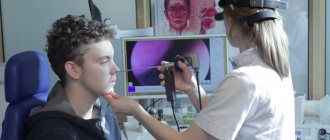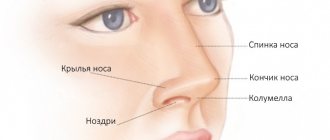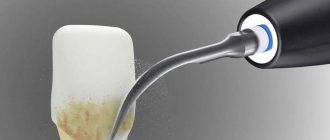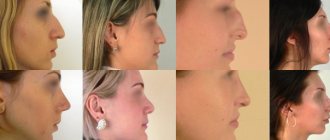Home > Laser surgery / Removal of tumors / Removal of lipomas > Laser removal of wen on the nose
Wen located on the nose, despite the fact that it does not pose a health hazard, causes aesthetic discomfort.
A fatty tissue (or lipoma) is a benign formation; it consists of adipose tissue, has clearly defined boundaries, and is usually soft and mobile. Such formations can be located on different parts of the body; they do not pose a danger, but when located on the face and especially on the nose, they cause aesthetic discomfort.
Consultation on the day of the procedure is free
1.Nose injuries
Nose injuries often occur during sports, accidents, fights and falls. Nasal pain, swelling and bruising usually occur with even the most minor injuries to the nose. The problem can usually be dealt with at home.
To tell for sure whether the nose is injured or broken
, the immediate aftermath of an incident can sometimes be difficult.
Swelling can cause the nose to become crooked even if there is no nasal fracture. When the swelling subsides after a few days, it will be easier to make a diagnosis. Most doctors prefer to make a diagnosis after the swelling begins to subside. Sometimes an X-ray or CT scan is needed to diagnose a nasal injury
, especially if the doctor has reason to suspect other facial injuries or fractures.
Whether the nose is broken or injured, a nose injury is considered serious when:
- There is bleeding from the nose that cannot be stopped on its own;
- The skin of the nose is intact, but there is reason to suspect serious internal damage. This increases the risk of infection;
- A blood clot forms in the tissues of the nasal septum. Because of this, perforation may appear in the septum or the bridge of the nose may be damaged;
- Trauma is caused by physical violence. Quite often it happens that in this case the person has other serious injuries. Not to mention the fact that such a case must be reported to law enforcement;
- You constantly have discharge from one or both nostrils. This may be cerebrospinal fluid that is released through the nose after a head injury or after surgery on the nose or ears. In such a situation, there is a possibility of developing an infection (for example, meningitis), which can affect the nervous system and be life-threatening.
A must read! Help with treatment and hospitalization!
Types of tumors of the nasal cavity and paranasal sinuses
Contents
hide
1 Types of tumors of the nasal cavity and paranasal sinuses
2 Causes 2.1 Symptoms 2.1.1 Diagnostic methods 2.1.1.1 Treatment methods
If the conclusion is “tumor”, the first thing that worries the patient is whether it is benign or malignant. The prognosis and method of treatment will depend on this factor.
Benign formations formed in the nasal cavity, paranasal sinuses and nasopharynx are divided according to location:
- on soft parts (hemangiomas vascular formations, myxoma, angiofibroma and many other varieties);
- on hard parts;
- mixed (teratoma, meningioma, etc.);
- tumor-like formations (polyps, cavities with fluids, hyperplasia, papillomas).
More often than others, hemangioma develops. It can appear at any stage of life with equal frequency in men and women. Hemangioma usually forms in the anterior part of the nasal septum - where the bones and cartilage meet. It looks like a bright red polyp, often bleeding due to the passage of many capillaries through it.
Malignant tumors of the nose and paranasal sinuses account for approximately 3% of all cancers. If we consider ENT tumors, the first place in frequency will be neoplasms of the larynx and laryngopharynx, and in second place will be the nose and adjacent areas. The maxillary sinus and nasal cavity are most often affected. Men suffer from this disease twice as often as women. Representatives of the stronger sex are at risk.
Cancerous tumors that affect the nose develop quickly, reaching the orbit and eye, the base of the skull, and sometimes its cavity. Squamous cell oncology leads in frequency (more than half). The growth in this case arises from the epithelium. In addition, the nose can become a place for the development of melanoma (a neoplasm developing from pigment), sarcoma (from connective tissue), and adenocarcinoma.
Inverted papilloma occupies a special place. This is a benign neoplasm of the paranasal region with a high risk of becoming malignant, which happens with poor quality treatment.
2. Consequences of nasal injuries
Most nasal injuries heal on their own without any complications. But it also happens that a nose injury causes a number of problems:
- Change in size or shape of the nose, crooked nose. Repeated trauma to the nose, especially during childhood, increases the likelihood of damage to the tissues and structures of the nose. And this in turn can cause constant problems;
- Difficulty breathing and nasal congestion;
- Infection of the nose, sinuses, or bones in the face;
- Perforation (hole) of the nasal septum;
- Severe infection such as meningitis or brain abscess.
Treatment of nasal injury,
not associated with a nasal fracture (when all the bones are in place), usually consists of relieving swelling and pain relief. In rare cases, a nasal splint is required.
If the nose is broken, it is usually diagnosed a few days after the incident, when the swelling has subsided and a broken nose can be differentiated from other nasal injuries. Usually, if the nose is injured, the swelling subsides after 2-3 days, but the swelling can last for one to two weeks. When treating a nasal fracture, a fixation splint can also be installed. A course of antibiotics will help prevent infection. As a rule, a nasal splint does not last long. After 2-3 days it will be removed and the doctor will re-examine it.
In case of nasal injuries, you need to check the possibility of other injuries - the head, face and neck. For example, a fractured cheekbone, eye injury, injury to the mouth or teeth, and injuries to the cervical spine.
Visit our Traumatology and Orthopedics page
What could it be
A bump on the nose often indicates some pathological process. Experts identify several types of neoplasms that can manifest themselves in this way.
Hemangioma
This is a benign neoplasm formed from capillaries and blood vessels. The growth does not cause pain. The skin in the affected area is bluish or reddish.
Treatment of the pathology does not present any difficulties. In rare cases, malignancy of the pathological process is noted.
Wen
This is a formation consisting of growing subcutaneous adipose tissue. In appearance it resembles atheroma, but in this case the site of its localization does not swell and is not accompanied by pain.
Wen, as a rule, is small in size and easily amenable to therapeutic manipulation.
Atheroma
This is a lump on the skin caused by blockage of the sebaceous glands. In appearance, the neoplasm is presented in the form of a lump with clearly defined contours.
As a rule, atheroma is elastic and painless when palpated. If an inflammatory process begins to develop, the patient complains of discomfort and suppuration at the site of the lesion.
Such a growth has a predisposition to degenerate into a malignant tumor. It is for this reason that it is not recommended to ignore it.
Fibroma, papilloma, warts
They are compactions on the skin of a pronounced nature. They may have a horny or spherical shape. Such growths are usually not painful and do not pose a health threat.
Despite this, if they occur, it is advisable to consult a specialist, since they can often be triggered by the papilloma virus and require increased attention.
Moles
They also belong to skin tumors, but with a high content of the coloring pigment melanin. Due to this, they are painted a darker color, different from the normal skin tone.
Such formations can only pose a danger if they are injured, as a result of which they often become chronic.
Lymphangioma
Such a growth also forms in the vessels of the lymphatic system. Not prone to rapid growth, it occurs in the nose area in rare cases. Treatment of the disease takes place without any difficulties.
Angiogranuloma
This tumor on the nose resembles a hemangioma in appearance. Experts call such formations polyps, the structure of which has a large number of capillaries. The growth is not predisposed to growth, but there is constant bleeding, which can cause a person some discomfort.
Keratosis follicularis
The cones are red-brown or reddish in color. They are dense to the touch, have an irregular shape and can grow. The cause of the development of pathology is a hereditary factor. To remove the tumor, doctors use cryodestruction - removal of the tumor using liquid nitrogen.
Herpes
This is an infectious process of the herpes simplex virus. Characterized by the formation of ulcers in the nasal area. Such growths are accompanied by pronounced pain. When the immune system is weakened, such rashes can occur constantly in large numbers.
3.When should you see a doctor?
In case of nasal injuries, it is important to consult a doctor promptly. Especially if:
- On the surface of the skin there are strong (including through) cuts from which blood flows (probably this is a fracture);
- If the nose is injured, difficulty breathing, speaking, or swallowing occurs;
- The nose looks swollen, uneven and generally not as normal;
- After the nose injury, vision changed;
- After a nose injury, there is bleeding that cannot be stopped on its own;
- After a nose injury, bruises appeared around the eyes and nose;
- Treating a nasal injury at home does not produce results;
- Unpleasant symptoms associated with nasal trauma become more frequent or stronger.
If you suspect that your nose is broken, do not try to set it yourself. It could get worse!
About our clinic Chistye Prudy metro station Medintercom page!
Causes of nasal polyposis
Modern medical science has not yet achieved a final understanding of why polyps form in some cases and not in others. However, there are known factors that contribute to the occurrence of polyps. These factors can be divided into two groups: local and general.
Local causes of the formation of nasal polyps are factors affecting exclusively the mucous membrane of the paranasal (paranasal) sinuses and nasal cavity. First of all, this:
- allergic rhinitis (chronic runny nose of allergic origin). This kind of runny nose is an allergic reaction to dust, pollen, and animal hair. Allergic rhinitis accounts for 80% of polyp formation;
- private colds;
- chronic sinusitis (inflammatory diseases of the paranasal sinuses) - sinusitis, frontal sinusitis, ethmoiditis;
- abuse of vasoconstrictors (drops for the common cold);
- curvature of the nasal septum, blocking the anastomosis of the nasal sinuses;
- fungal infection.
The formation of a polyp may be due to the influence of several factors.
Common factors that contribute to the formation of polyps are:
- individual reactivity (that is, the body’s ability to respond to certain challenges). There is a congenital predisposition to the formation of polyps. Also, the likelihood of polyps increases with age, since life circumstances can contribute to the development of a predisposition to this disease;
- state of the immune system;
- some systemic diseases.
If polyps are detected in the nose, it is recommended to undergo an examination of the intestines; it is possible that polyps have formed there too, but have not yet manifested themselves.
4.What to do if you have a nose injury?
A few simple tips will help you cope with pain, swelling and bleeding from a nasal injury.
- Apply ice. Cold will reduce pain and swelling. The sooner this is done after a nasal injury, the better. Cold compresses can be done three times a day for 10-20 minutes (no more). Never apply ice directly to the skin; wrap it in a cloth.
- Keep your head elevated while sleeping. This will help reduce swelling;
- Do not take non-steroidal anti-inflammatory drugs. Ibuprofen or aspirin taken within the first 48 hours of a nasal injury prolongs clotting time and may increase bleeding.
- Do not smoke. Smoking reduces blood supply and delays tissue repair. This means it slows down the healing of nasal injury.
Cost of removing lipomas (fat) with laser
| Laser tumor removal | Prices, rub. |
| Laser removal of papillomas, single warts - Cat. I. difficulties | 1200 |
| Laser removal of papillomas, multiple warts - Cat. I. difficulties | 350 |
| Laser removal of moles, papillomas, warts - Cat. II. difficulties | 700 |
| Laser removal of moles, papillomas, warts - Cat. III. difficulties | 1500 |
| Laser removal of moles, papillomas, warts - IV category. difficulties | 3000 |
| Laser removal of moles, papillomas, warts - Cat. V. difficulties | 4500 |
| Laser removal of moles, papillomas, warts - Cat. VI. difficulties | 6100 |
| CO2 Laser callus removal (per unit) | 6100 |
| Removal of atheroma, lipoma, fibroma, xanthelasma with laser - Cat. I. difficulties | 6 900 |
| Removal of atheroma, basal cell carcinoma, lipoma, fibroma, xanthelasma with laser - Category II. difficulties | 9 400 |
| Removal of atheroma, basal cell carcinoma, lipoma, fibroma, xanthelasma with laser - Cat. III. difficulties | 16 900 |
| Removal of atheroma, basal cell carcinoma, lipoma, fibroma, xanthelasma with laser - IV category. difficulties | 22 400 |
| Removal of atheroma, basal cell carcinoma, lipoma, fibroma, xanthelasma with laser - Cat. V. difficulties | 33 400 |
Make an appointment for laser removal of wen on the nose
- Full name
- Telephone
To remove various tumors, surgical, radio wave and laser methods are used. The surgical method is used to remove large fatty deposits.
A laser is used to remove wen on the nose.
This method will allow you to quickly and painlessly get rid of the wen.
- After it there are no scars left on the skin.
- The laser acts specifically on the tumor and does not affect healthy tissue, eliminating the possibility of accidental damage.
- The formation is excised completely, it can be immediately sent for histology.
- During the procedure, the laser simultaneously coagulates the surrounding tissue, so the intervention is less traumatic.
- The risks of infection are reduced and the rehabilitation period is shortened.
- Laser treatment has a very short recovery period.
- This method almost completely eliminates the occurrence of relapses.
How does laser removal of wen occur?
When removing a tumor on the nose using a laser, local anesthesia is used. A high-precision, small-diameter laser is used.
The operation is quick and takes no more than 15-40 minutes. The duration of the operation depends on the size and location of the tumor.
Usually on the same day the patient returns to his normal routine and does not experience any restrictions.










